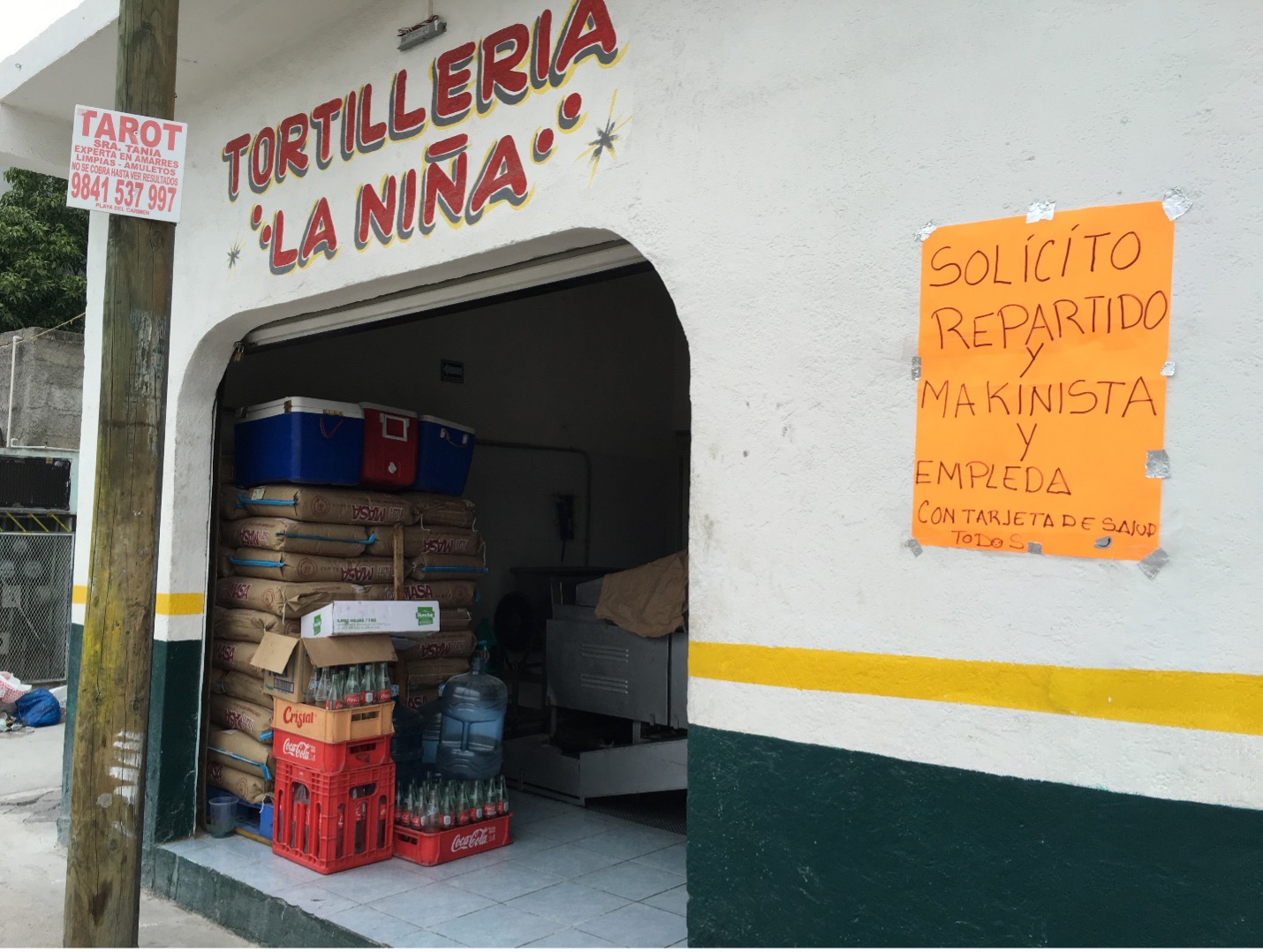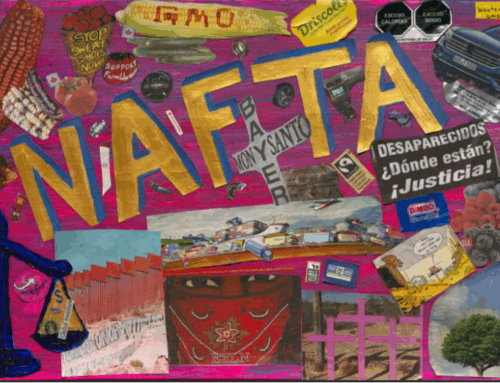María migrated from Mexico to New York in 1997 to reunite with her partner, who had left two years earlier. When we met in 2000 at a Bronx parish, I was conducting doctoral research, and she and I have remained in contact—as interlocutors and as friends—since then. Most of her partners’ nine siblings had already migrated, leaving their youngest siblings and parents at home in their rural community near Tehuacán, Puebla. La Mixteca, comprising the states of Puebla, Oaxaca and Guerrero, had not been considered a migrant-sending region before the mid-1990s. Since then, however, a substantial portion of the population has relocated to New York; Las Vegas, Nevada; Portland, Oregon; and other destinations.[i]
María told me, in a conversation in October 2023, that for the first ten years after she migrated, her mother was convinced that she was suffering. Even though María tried to reassure her on the phone, her mother remained certain that she was fibbing to protect her. Because María did not have papers that would allow her to leave the United States and re-enter, and her mother could not obtain a visa, the relationship between them for the last fifteen years of her mother’s life was sustained entirely through phone calls. In these conversations, María’s mother would try to discern whether the reassurances she heard were genuine.
María herself admitted that she often painted a rosier picture for her mother than reality warranted, concealing the extent of her grief at being separated from her and deprived of her care during difficult moments. As she explained, members of too many families in their community had migrated to the United States and struggled—economically, socially, emotionally, or all of the above. Far from expecting the streets to be paved with gold, María’s mother likely thought of the United States as a golden cage, as did many in her community, echoing the words Los Tigres del Norte used to describe it in their song “La Jaula de Oro”:
De qué me sirve el dinero
Si estoy como prisionero
Dentro de esta gran nación
Cuando me acuerdo hasta lloro
Aunque la jaula sea de oro
No deja de ser prisión
Of what use is money
If I live like a prisoner
Inside this great nation
And when I think of it, I cry
Even though this cage is made of gold,
It does not cease being a prison[ii]
María is convinced that the early and severe onset of kidney disease and diabetes that claimed her mother’s life before her mid-sixties was the result of the grief caused by family separation. In spite of residing in the United States for nearly three decades, María and her husband are no closer today to legal status than when they arrived. They were not eligible for the Immigration Reform and Control Act of 1986 (IRCA, commonly referred to as “Amnesty”), because they arrived too late. Nor were they eligible for Deferred Action for Childhood Arrivals (DACA), a policy that does not provide legal status but does protect certain people from deportation and allows them to work, because they had aged out by the time it went into effect. They also did not qualify for a professional or special immigrant visa, since their skills and knowledge were not credentialed in ways legible to the state. Nor did they fall under any of the subsequent provisions for Temporary Protected Status (TPS), which have allowed nationals of certain countries to migrate and work with authorization. They would have been eligible for Deferred Action for Parents of Americans (DAPA), an executive order announced by President Barack Obama in 2014, but it was prevented by the courts from going into effect.
María and her husband have nevertheless continued working, raising their U.S.-born children, and living their lives within this legal limbo. Since their arrival, the only legislative changes in relation to migration that have gone into effect have made border crossing still more dangerous and difficult rather than facilitating mobility.
Like an estimated four million Mexicans who came to the United States in the mid-1990s, María and her partner remain undocumented, lured by the promise of greater opportunity thirty years ago and never granted the most basic privilege of mobility between their country of origin and country of settlement (Gonzalez-Barrera 2021). When María’s mother passed away several years ago, María said she considered giving up everything she had in the United States to go back and bury her mother. But that would have meant possibly losing the opportunity to live with and raise her U.S.-born children as they approached adulthood. These weighty decisions—to go or to stay, to be with some members of one’s family at the expense of decades separated from other loved ones—remain the norm for many.
Immobility still ensnares the majority of the people with whom I first engaged as interlocutors in research on migration from Mexico to New York in 2000. While a few of the people I know have been lucky, qualifying for a particular kind of visa or status adjustment, they are outnumbered by those who remain in limbo.[iii] The organizations and grassroots mobilizations that twenty years ago viewed immigration reform as inevitable and imminent (Gálvez 2010) have now, for the most part, disbanded and faded from public view. The fight for immigration reform has been obscured by a rising tide of nativism that has made any nationwide discussion of immigration reform impossible and even “unsayable” (Dauvergne 2016). While some activists and advocates operate detention and deportation defense activities to try to keep individuals from being deported, and others engage in charitable activities for refugees and asylum seekers, the large-scale, grassroots, demographically diverse coalitions working for broad immigration reform have mostly receded from view.
María and her husband, like millions of Mexicans, were refugees—directly or indirectly—of the changes wrought by NAFTA.[iv] Their displacement and ongoing disenfranchisement, however, are not commonly considered in tallies of the benefits and costs of the trade agreement. When the North American Free Trade Agreement was negotiated, human mobility was not up for consideration. In shopping around its idea of a trade deal, Mexico originally envisioned a unified North American economy with the free circulation of goods, capital, and people. However, in the conceptualization of “free” trade that emerged, capital and goods would move as if there were no borders, but people would not. Fears of unfettered migration from Mexico to the United States had shaped the U.S. approach to North American policy before and would again. Mexican negotiators, therefore, made a strategic decision not only to refrain from pushing but also not even to propose human mobility as part of the deal, lest the deal evaporate before it could even be outlined (Derbez 2006).

Figure 1. The farmers’ market space in Piaxtla, Puebla, Mexico, is now largely dedicated to the sale and resale of consumer goods such as CDs, batteries, and toys. Photo by Alyshia Gálvez.
Although the trade deal was pitched by political leaders to all three countries as a way to bring prosperity and job growth—and thus to counter migration—approximately 10 percent of Mexico’s population found itself outside of Mexico within a decade of the launch of NAFTA, reaching a peak of 12.8 million people (Gonzalez-Barrera 2021). This statistic sometimes escapes contemplation, so it is worthwhile to restate differently: in today’s terms, this would be the equivalent of 3.8 million Canadians or 33 million people from the United States leaving since 2014. Even though the United States has long been a destination for Mexican migrants (and unregulated circulation of people in this region long preceded the current national borders), this was a massive and unprecedented displacement. It coincided so directly with the trade deal that we must consider the vast majority of those displaced to be refugees from NAFTA. Because no provision was made for human mobility, most of these migrants assumed on their own shoulders the burdens, costs and risks of unauthorized migration, while also being framed in public discourse as perpetual “illegal aliens”—exploitable sources of cheap labor and undesirable Others scapegoated by rising nativist nationalism.
An article published in September 2024 in the New York Times claimed that NAFTA broke U.S. politics: “It ushered in an era of free-trade agreements that brought cheap goods to consumers and generated great wealth for investors and the financial sector, but it also increased income inequality, weakened labor unions and accelerated the hollowing out of America’s [sic] industrial base” (Kaufman 2024). This, Kaufman argues, opened the door to Trump’s anti-trade, anti-globalization, protectionist, and xenophobic policy stance. Decades of analyses have preceded Kaufman’s in pointing out the connection between economic and physical displacement since NAFTA, as well as the restructuring and deindustrialization that preceded it. Immigration, and trends in attitudes about it, are given less attention than manufacturing jobs and deindustrialization in most U.S. media accounts of NAFTA. The perception in the United States that manufacturing jobs went south with NAFTA has heightened the framing of immigrants as scapegoats rather than as victims of the same larger economic and political forces (Gonzales, Rosaldo, and Pratt 2021). Physical expulsion of immigrants in a second Trump term are part of a fantasy of a return to prosperity. But Mexicans have been targeted with particular xenophobic and nativist ire for more than a century and a half in the United States.
Romantic visions of the United States as a melting pot—where immigrants can arrive, blend in, and thrive in a generation—have consistently been trumped by discourses that perpetually other Mexicans, framing them as new arrivals, interlopers, and invaders (Hernandez 2010). It is not only aversion to migrants in general that prevents a U.S.-Mexico policy for the free flow of people alongside trade, but specifically anti-Mexican hate that often renders such discussions anathema.

Figure 2. Like many tortilla shops, this one in Playa del Carmen, Quintana Roo, Mexico, makes tortillas with industrial corn flour rather than freshly ground local maize. Photo by Alyshia Gálvez.
But NAFTA did not have to be like this. While no paradise, the unification of the countries of Europe into the European Union at least allowed for labor mobility within the economic zone, in a way that acknowledged the reality of a revised distribution of economic activity across the member states. While European unification has heightened the risks and persecution of unauthorized migrants from outside the union (De Genova 2014), it authorized migration within the union. In contrast, it is unusual and illogical that North American trade unification did not include provisions for labor mobility. Many migrants from Mexico never desired long-term settlement, much less prolonged limbo in the United States, and given the opportunity, would have responded, as migrants always do, to changing economic conditions in both countries in a fluid and responsive way.
The assumption that people in Latin America are universally longing to live in the United States is a stereotype as common as the racist and xenophobic images of Mexicans as invaders. In fact, since the U.S. economic recession in 2008, more people have left the United States for Mexico than have migrated from Mexico to the United States (Gonzalez-Barrera 2021). The gates—literal and figurative—between the U.S. and Mexico are, for most, one-way turnstiles: passage from north to south is easy, while passage from south to north is difficult. NAFTA could easily have created two-way turnstiles, or removed the turnstiles entirely. Past policy mistakes that fostered rampant exploitation and disenfranchisement decades before NAFTA (Hernandez 2010) could have been addressed with better policies, rather than with no policy at all, or with a policy of violent deterrence and a militarized Southern border (De León 2015).
It is not too late. Thirty years of NAFTA and the approaching recertification of the trade deal in 2026 are an appropriate opportunity for consideration of a different deal, one with the well-being of communities in all three countries at its core. Along with permitting the flow of goods and capital (if that is what makes sense in the twenty-first century), a policy allowing for the movement of citizens of the three countries could be undertaken as a pilot for the elimination of barriers to mobility across the hemisphere (with unification of the CAFTA zone following on NAFTA), and eventually the world. Such a policy could achieve stronger continental environmental and labor protections, the expansion of the right of communities to remain on their ancestral lands, and mutual prosperity and safety. The right to stay is as important as the right to move (Bacon 2014).
Real freedom, of course, lies outside of trade deals and even outside of nation states (Jones 2018; Dauvergne 2016; Benjamin 2024; Washington 2024). It is arguable that the only ethical response is the elimination of borders. Yet in the meantime, amid raging nativism, there remains potential for creative and humanitarian responses within the existing tri-national policy environment. Understanding how trade deals fuel deterritorialization could lead to policy fixes that foster safer mobility.
Twenty-first century migration may also continue to take surprising forms. While the climate crisis is already the harbinger of intense displacement (Lustgarten 2020; Carney 2024) we also see growing numbers of people leaving the global north for the global south, whether as part of a teleworking or digital nomadism, or as expatriates escaping gun violence or nativism (Carney manuscript in process). Labor scarcity in the global north is a growing concern, while many who migrated for economic opportunity may now be plotting a return to their countries of origin in the absence of retirement or health benefits in the places where they have spent their working lives.
Migration is, and has always been, a constant in human and more-than-human populations. Rational policies would acknowledge the futility of stemming or stopping migratory flows and would instead focus on regulating them for optimal safety and efficiency. The suffering caused by ill-advised containment policies—which funnel global migrants to dangerous pathways where they are preyed upon by lethal forces, whether in the Darién gap, the Mediterranean Sea, or the Sonoran desert—is a policy choice, a logical outcome of failing to anticipate displacement as a result of economic and political changes. Different futures are possible.
Notes
[i] Between 1990 and 2015, the Mexican population was the fastest growing Latino national subgroup in New York City increasing from about 58,000 to 377,000 people (Smith 2005; Martinez 2019; Marroni and Alonso Meneses 2006; Ortega and Walsh 2016; Délano 2011). For more about María’s story, see Fuentes and Gálvez (2025).
[ii] Lyrics to Los Tigres del Norte’s La Jaula de Oro, translated by author.
[iii] I use “lucky” facetiously, as one pathway to legalization several people I know have used is a “U-visa” which is available to certain victims of crimes who agree to testify against the person who harmed them. Many of those who have been able to regularize their status through this or another pathway remain ambivalent about their ability to adjust their status, both because of the harm they endured to be eligible for them and because they often know many others, including close family members, whose own status remains illegible for regularization.
[iv] In their region, these changes included an end to agricultural subsidies and public investment in food provisioning systems that connected rural farmers and urban markets; a decline in the price of corn and other locally grown foodstuffs; the closure of opportunities to export avocados and sugar; and more (Gálvez 2018).
References
Bacon, David. 2014. The Right to Stay Home: How US Policy Drives Mexican Migration. Boston: Beacon Press.
Benjamin, Ruha. 2024. Resisting Borders and Technologies of Violence. Chicago: Haymarket Books.
Carney, Megan A. 2024. “The Climate-Food-Migration Nexus: Critical Perspectives.” Global Food Security 42: 100786.
———. Manuscript in process. “Exit from the United States: Emigration, Carcerality, and Abolition Feminist Futures.”
Dauvergne, Catherine. 2016. The New Politics of Immigration and the End of Settler Societies. Cambridge: Cambridge University Press.
De Genova, Nicholas. 2014. “Extremities and Regularities: Regulatory Regimes and the Spectacle of Immigration Enforcement.” In The Irregularization of Migration in Contemporary Europe: Detention, Deportation, Drowning, edited by Yolande Jansen, Robin Celikates, and Joost de Bloois, 3–25. London: Rowman & Littlefield.
De León, Jason. 2015. The Land of Open Graves: Living and Dying on the Migrant Trail. American Crossroads 36. Berkeley: University of California Press.
Délano, Alexandra. 2011. Mexico and Its Diaspora in the United States: Policies of Emigration since 1848. Cambridge: Cambridge University Press.
Derbez, Luis Ernesto. 2006. Interview with Former Foreign Minister of Mexico, Luis Ernesto Derbez.
Gálvez, Alyshia. 2010. Guadalupe in New York: Devotion and the Struggle for Citizenship Rights among Mexican Immigrants. New York: NYU Press.
Gálvez, Alyshia. 2018. Eating NAFTA: Trade, Food Policies, and the Destruction of Mexico. Oakland: University of California Press.
Gonzales, Phillip B., Renato Rosaldo, and Mary Louise Pratt. 2021. Trumpism, Mexican America, and the Struggle for Latinx Citizenship. Albuquerque: University of New Mexico Press.
Gonzalez-Barrera, Ana. 2021. “Before COVID-19, More Mexicans Came to the U.S. than Left for Mexico for the First Time in Years.” Pew Research Center (blog). July 9, 2021.
Hernandez, Kelly Lytle. 2010. Migra! A History of the U.S. Border Patrol. American Crossroads 29. Berkeley: University of California Press.
Jones, Reece. 2018. Open Borders: In Defense of Free Movement. Geographies of Justice and Social Transformation. Athens: University of Georgia Press.
Kaufman, Dan. 2024. “How NAFTA Broke American Politics.” The New York Times, September 3, 2024, sec. Magazine.
Los Tigres del Norte Oficial, director. 2019. Los Tigres Del Norte – La Jaula De Oro (Audio). YouTube video, 3:12.
Lustgarten, Abrahm. 2020. “The Great Climate Migration.” New York Times Magazine, July 23, 2020.
Marroni, María da Gloria, and Guillermo Alonso Meneses. 2006. “El Fin Del Sueño Americano: Mujeres Migrantes Muertas En La Frontera México-Estados Unidos.” Migraciones Internacionales 3 (3): 5–30.
Martinez, Isabel. 2019. Becoming Transnational Youth Workers: Independent Mexican Teenage Migrants and Pathways of Survival and Social Mobility. New Brunswick: Rutgers University Press.
Ortega, Adriana Sletza, and María Walsh. 2016. “Migration Studies Puebla-New York.” Practicing Anthropology 38 (1): 23–25.
Smith, Robert. 2005. Mexican New York: Transnational Lives of New Immigrants. Berkeley: University of California Press.
Washington, John. 2024. The Case for Open Borders. Chicago: Haymarket Books.
Alyshia Gálvez is a cultural and medical anthropologist. She is professor of Latin American and Latino Studies at Lehman College and of anthropology at the Graduate Center of the City University of New York.
Cite as: Gálvez, Alyshia. 2025. “Immobility and the Grief of Families Separated by the Border”. In “Anthropology of Free Trade”, edited by Alejandra González Jiménez, American Ethnologist website, 11 November. [https://americanethnologist.org/online-content/immobility-and-the-grief-of-families-separated-by-the-border-by-alyshia-galvez/]




